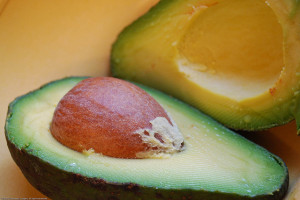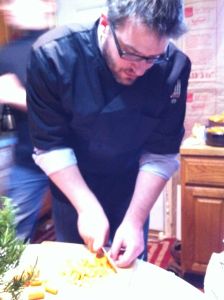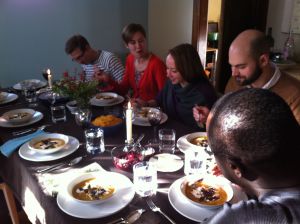It is large and green and looks so inviting. I imagine it mashed in a bowl with a jalapeño, a hint of tomato, some spices. But I can’t do it. I can’t spend $2.99 for an avocado, not even an organic one. I walk out of the store with my bag of kale and wine, avocado still on the grocery list in my mind.
One birthday, when I was in my teens, I asked my aunt to send me some avocados from her tree in Southern California, where I spent my first seven years. The box winged it’s way through two states and arrived at my Washington State door in February. Her avocados were different than the ones I could buy at the store, they weren’t as bumpy, or as small. All too soon, they were gone.
At least once a week, when I was growing up, we had tacos. My mom would pour a generous helping of oil into a skillet and fry our tortillas until they were crispy. Sometimes, we would fill them with equally crispy fish, cut into small pieces, coated in flour and sizzled in a neighboring pan. Other days, she would brown ground beef or turkey while I grated cheese and sometimes tore lettuce.
We would put all of the ingredients into the sections of a plastic tray. It was our taco tray, and I never thought to question whether it could have another purpose. Each member of my family would pile their shell high with the filling of their choice. I always made sure to add a generous dollop, or two, of guacamole.
When we had guests for dinner, after we moved to Washington, there was often a conversation about the way we served our tacos. In the Pacific Northwest, I learned, most people purchase pre-formed “taco shells” which seemed much more like large, curved tortilla chips to me. For the very brave, tacos were made with cold, soft tortillas. I was a polite child, and I ate these foreign foods without complaint when at friend’s houses, invited to stay for dinner.
When I went away to college in central Indiana, I was thrilled to be paired with a roommate from Texas. She will understand, I thought. We will pursue authentic Mexican food together.
Her uncle, a professor at our university, invited us for lunch some Sundays. On one such occasion, my roommate made guacamole. I watched, with mounting horror, as she added spoonfuls of Miracle Whip and stirred it in.
We were saying the same words, but we did not mean the same thing. It has taken me a long time to try Tex-Mex again.
On my visits to San Diego, my birthplace, I often see avocado trees from the window of our rental car. These trips are filled with family, driving, and the beach. Still, no matter how long I’m there, I always venture to Old Town, to a little place we used to go when I was small. I pause to watch the women in the window, making tortillas by hand as fast as they can. The perfect distraction, while waiting to be seated at the busy part of the day.
When my brother and I were little, my parents would order two Tostada Supremas and fresh flour tortillas. We would all make tacos out of these plates, which seemed monstrously big to my little eyes.
Now, when I go, I order a Tostada Suprema all my own, with extra guacamole, and a margarita. Somehow, I usually manage to finish the plate (though I have carried leftovers with me on the plane, inspiring jealousy in my fellow passengers).
Periodically, I buy some oil, tortillas and ground beef. I’ve been waiting for the price of avocados to go down, but they never seem to fall very far. I compare the small green fruit to a coffee, measuring it against any other indulgence, and it usually makes it’s way into my basket.
 I fold a paper towel and put it on a plate, ready to catch the excess oil from the golden brown tortilla, waiting to be filled.
I fold a paper towel and put it on a plate, ready to catch the excess oil from the golden brown tortilla, waiting to be filled.
I cut the avocado in half and draw parallel lines with my paring knife, just as my mother used to, scooping the resulting little squares into a bowl with a spoon. Always, I sigh with relief when the inside is green and a little firm. There is nothing like the disappointment of an avocado too ripe to eat.
I don’t belong in the land of my birth any more than I belong in the mountains and valleys of the Northwest. My roots don’t lead to any one place of belonging, but to many. Still, when I take a bite and close my eyes, I taste the peace of that which is familiar and much-loved, and I’m glad that I splurged on the avocado after all.
* * * * *
 “The Price of Avocados” was written by Cara Strickland. Cara has lived in San Diego, California, London, England, and Upland, Indiana. Once, in college, she wrote an essay saying that she was from Narnia. She currently lives in Spokane, WA, where she is a writer, blogger, editor, and food critic. She almost always finds a way to write about food. Cara blogs at “Little Did She Know” and can be found on Twitter @littledidcknow.
“The Price of Avocados” was written by Cara Strickland. Cara has lived in San Diego, California, London, England, and Upland, Indiana. Once, in college, she wrote an essay saying that she was from Narnia. She currently lives in Spokane, WA, where she is a writer, blogger, editor, and food critic. She almost always finds a way to write about food. Cara blogs at “Little Did She Know” and can be found on Twitter @littledidcknow.
(Avocado photo curtesy of HarmonyRae.)

